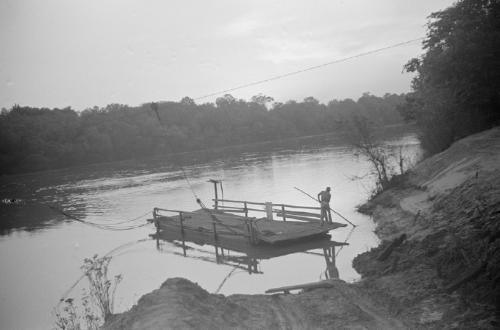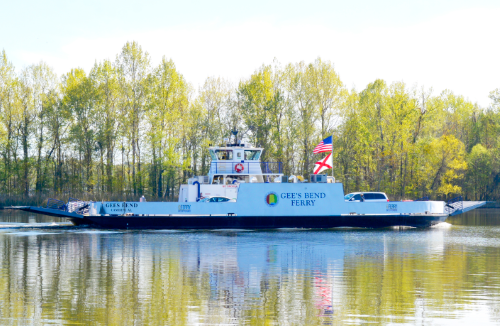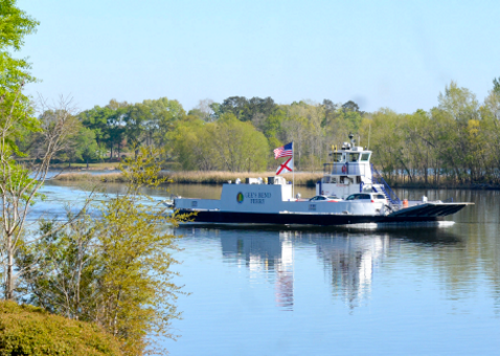For two years, the Alabama Department of Transportation has quietly run an all-electric passenger and vehicle ferry, giving a tiny African-American community the distinction of having the only such vessel in the United States.
[Photo courtesy of the Alabama DOT.]
The story of how this unique ferry wound up in Gee’s Bend exemplifies the fundamental role transportation plays in civil rights, environmental, and social justice issues.
In the 1900s, Gee’s Bend had a hand-powered ferry – a wooden raft tethered to a cable stretched across the Alabama River. The old ferry linked Gee’s Bend – a community of about 300 people – to Camden, the county seat, where most of the grocery stores, schools, medical facilities, and government offices – including the voting registrar – are established. Without it, a 15-minute drive from Gee’s Bend to Camden turns into an hour-long journey.
“God blessed us to be able to have this ferry,” said Mary Ann Pettway, a champion African-American quilter and lifelong resident of Gee’s Bend. “That ferry is very important to all of us.”

Photo courtesy of the Alabama DOT.
However, as the civil rights movement rippled through Gee’s Bend in the 1960s, the ferry disappeared without explanation. The truth of its demise is as murky as the river it crossed, but the loss symbolized a host of injustices heaped upon the people of Gee’s Bend, who had limited access to jobs, education, medical care or emergency services.
That all began to change one night in 1993 when Hollis Curl – owner of The Wilcox Progressive Era, the county newspaper – looked across the river toward Gee’s Bend and saw smoke rising from a house fire. He knew the house was doomed and everyone inside was in danger because there was no ferry to get firefighters there in time.
“When I was a child, I remember him talking about it,” said Ethan Van Sice, the grandson of Curl, who died in 2010. “People’s houses were being burned down. He saw that smoke across the river and I think something in him clicked.”
Curl penned a front-page editorial, arguing that re-establishing the ferry would be good for both communities. The increased mobility, Curl wrote, would provide the children in Gee’s Bend with a chance at a better education and a better quality of life for everyone.
People in Camden were astonished at the newspaper’s editorial shift, but Curl’s words left them unmoved.
“It wasn’t totally received well,” Van Sice said.
Undeterred, Curl started a crusade to re-establish the ferry – and he found a willing partner in the Alabama DOT or ALDOT.
“We saw a need there,” said Josh Phillips, a public information officer for the agency. “We said, ‘We need to find a way to make this happen.’ It became a special project for ALDOT.”

Photo courtesy of the Alabama DOT.
After years of planning and some federal funding, the Alabama DOT finished the ferry in 2006, reconnecting Gee’s Bend to the rest of the world.
The ferry broke down often, however, and the service was unreliable. Ultimately, the agency decided to convert the ferry from diesel to electric power, replacing all the diesel components electric parts, lithium-ion batteries, cooling systems, and a computer and software package to orchestrate the operation.
The Alabama DOT also negotiated with two power companies to get sufficient electricity to each landing to re-charge the ferry’s massive batteries between trips.
In spring of 2019, it all came together, and the first all-electric ferry in the United States purred across the Alabama River from the Camden terminal to Gee’s Bend.
Mike Wilson of the Alabama DOT said other state departments of transportation can make the conversion to all-electric in certain situations.
“The technologies are pretty much off-the-shelf technologies, so it’s doable in the right circumstances,” he said. “Most operations that are trying to do something like this go to a hybrid boat simply because the routes are longer. Our route is such that we didn’t need to do that.”
Tim Aguirre, general manager of HMS Ferries Alabama, said the first lesson is “don’t start from scratch. There’s a lot of experience out there on this, and there are engineering firms that know how to do this.” Having the nation’s first all-electric ferry in Gee’s Bend is “a fascinating story with a neat outcome,” Aguirre said. “Ferries connect communities; they always have.”


